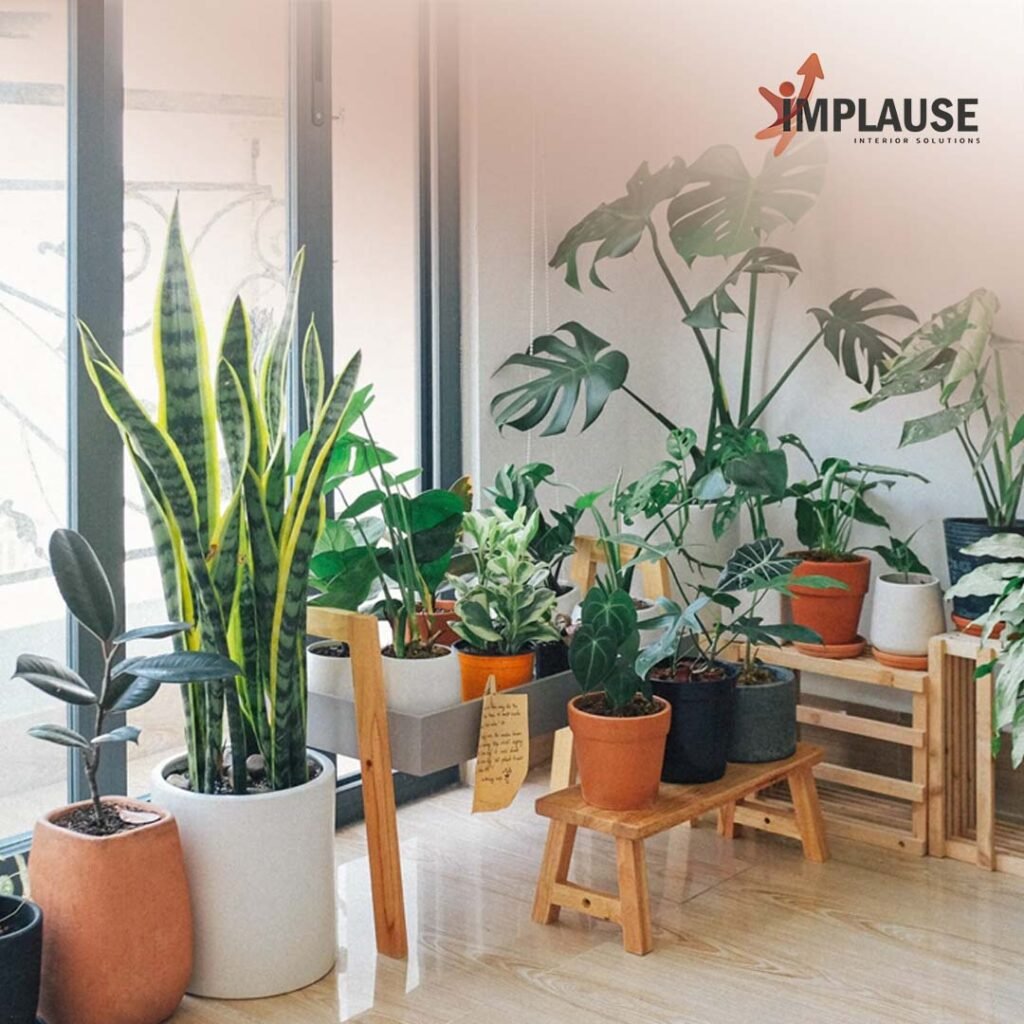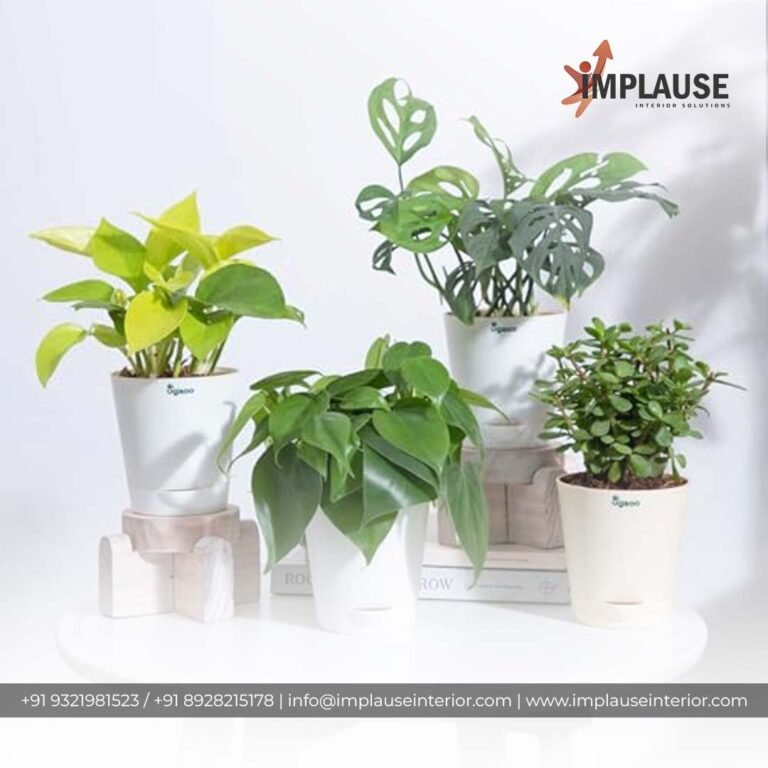By Implause Interior | On Sep 3, 2024
How to Use Indoor Plants for Aesthetic & Air Quality

Indoor plants have become a popular choice for homeowners looking to enhance their living spaces. Not only do they add a touch of nature and elegance to any room, but they also offer a range of health benefits, including improved air quality.
If you’re interested in integrating indoor plants into your home design, here’s a comprehensive guide on how to do it effectively, along with tips from a home interior designer in Pune.
Benefits of Indoor Plants
Before diving into design tips, it’s essential to understand the benefits of indoor plants. They do more than just beautify a space:
- Improved Air Quality: Plants absorb pollutants and release oxygen, which can help purify the air. They can reduce levels of indoor pollutants like formaldehyde, benzene, and trichloroethylene.
- Increased Humidity: Through a process called transpiration, plants release moisture into the air, which can help maintain optimal humidity levels and reduce dryness.
- Enhanced Mood and Productivity: Studies have shown that being around plants can reduce stress, increase feelings of well-being, and boost productivity. They contribute to a more relaxed and pleasant atmosphere.
- Aesthetic Appeal: Indoor plants can complement various design styles, from modern and minimalistic to rustic and eclectic. They add texture, color, and life to your home decor.
Choosing the Right Plants
Selecting the right plants for your space is crucial. Consider the following factors:
- Light Levels: Determine the light conditions in each room. Some plants thrive in bright, indirect light, while others can survive in low-light conditions. For example:
- Low-Light Plants: Snake plant, ZZ plant, Pothos
- Bright, Indirect Light Plants: Ferns, Spider plant, Peace lily
- Maintenance: Choose plants that match your ability to care for them. Some require frequent watering and attention, while others are low-maintenance.
- Size and Growth: Consider the size of the plant and how it will grow. Larger plants can serve as focal points, while smaller plants can be used as accents.
- Allergies and Pets: Ensure the plants you choose are safe for children and pets. Some plants can be toxic if ingested.
Design Tips for Incorporating Indoor Plants
Here’s how you can integrate indoor plants into your home’s interior design:
- Create a Green Wall: A living wall or vertical garden is a striking way to add greenery to a room. It can serve as a feature wall or act as a natural partition. This can be a great project to discuss with a residential interior designer in Pune, who can help with the installation and design.
- Use Decorative Pots: Stylish pots and planters can enhance the overall look of your plants. Choose pots that complement your existing decor. Ceramic, metal, and woven baskets are popular choices.
- Group Plants: Arrange plants in groups to create visual interest. Vary the heights and types of plants for a dynamic look. Plant stands and shelves can help in organizing and displaying your plants effectively.
- Incorporate Plants into Furniture: Integrate plants into your furniture design. For instance, you can use plant-filled shelves, built-in planters, or even table centerpieces.
- Create Plant Corners: Dedicate a corner of a room to a variety of plants. This can become a mini indoor garden that adds a vibrant touch to your home.
- Hang Plants: Hanging plants or macramé plant holders are excellent for small spaces. They can add greenery without taking up floor space.
- Mix Plants with Art: Combine plants with art pieces or decorative objects. This can create a cohesive and visually appealing design.
FAQs
Q: What are the best indoor plants for low light?
A: Some of the best indoor plants for low light conditions include the Snake plant, ZZ plant, and Pothos. These plants can thrive in areas with minimal natural light.
Q: How often should I water my indoor plants?
A: Watering frequency depends on the type of plant and its environment. Generally, it’s best to let the soil dry out slightly between waterings. Overwatering can lead to root rot.
Q: Can indoor plants really improve air quality?
A: Yes, indoor plants can help improve air quality by absorbing pollutants and releasing oxygen. However, their effect on overall indoor air quality may be limited compared to mechanical air purifiers.
Q: Are there indoor plants that are safe for pets?
A: Yes, there are several pet-friendly plants, such as Spider plants, Boston ferns, and Areca palms. Always check the toxicity of plants before bringing them into your home if you have pets.
Conclusion
Incorporating indoor plants into your home design not only enhances aesthetic appeal but also contributes to better air quality and overall well-being. Whether you’re working on a new design project or simply looking to refresh your space, consulting a home interior designer in Pune can provide you with tailored advice and creative solutions. Implause Interior, with its expertise in residential and commercial design, offers comprehensive services to help you achieve your ideal living space.
Explore more about our interior design services and how we can assist you in creating a beautiful, functional home at Implause Interior.
Book an Appointment Now
You book a consultation, get guided by one of the best interior designers, and we take care of the rest, from start to finish. We have done it for more than 1000+ homes already.


sERVICES
- +91 9321981523
- +91 8928215178
- info@implauseinterior.com
- Core Building, 3rd floor,Office No. 306, NIBM Road, Pune, Maharashtra 411048
subscribe
Don’t miss out on our valuable content subscribe now!
